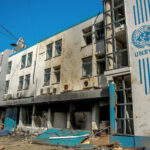Iran’s drone and missile strike on Israel on Saturday evening has reshaped the established rules of engagement between these two opposing nations. This incident has escalated tensions in the Middle East, bringing the region closer to a broader conflict with potentially destabilizing consequences.
Since Iran’s 1979 revolution, its stance against Israel has been clear and consistent. As part of its strategy, Iran has supported the ‘axis of resistance’ network in Lebanon, Syria, Iraq, Yemen, and Palestine, which surrounds Israel’s borders. These groups, including Bashar al-Assad, Hezbollah, the Houthis, and various Iraqi factions, have evolved from being proxies to autonomous partners coordinating across borders.
The October 7 attacks prompted Israel to reconsider its strategy towards Iran and the broader resistance axis due to the failure of its previous approach to ensure security.
Since October 7, Israel has targeted key figures coordinating the axis of resistance and Iranian assets across borders. Over the past six months, more than 18 members of the IRGC Quds forces have been killed, along with an attack on Iran’s embassy compound in Damascus. Attacks on a nation’s diplomatic mission are a breach of the Vienna Convention and a breach of international law.
Iran has consistently expressed its desire to avoid a broader regional conflict, which might have influenced Israel’s new strategy. Until recently, Iran avoided direct retaliation against Israeli provocations, relying on its proxies or avoiding confrontation entirely, leading to criticism of its deterrence capabilities.
The recent direct strikes against Israel aimed to restore Iranian deterrence and signaled a change in Tehran’s risk tolerance. Iran’s IRGC commander, Hossein Salami, described this as an attempt to establish a “new equation” with Israel.
Tehran intended to set new boundaries in its conflict with Israel, emphasizing that Iran is prepared to take action if Israel continues its campaign against Iran and its allies.
Iran’s decision not to employ faster, precision-guided ballistic missiles suggests a calculated move to avoid causing significant damage to Israel. Timing may also have played a role, with Iran possibly wanting to escalate tensions before the US election.
Despite the alleged near-perfect interception rates by Israel’s defense systems, the attack achieved its strategic goals from Iran’s perspective. It forced Israel and the US to invest over a billion dollars in defense measures, potentially affecting US military assistance to Israel.
However, the attack had unintended consequences, including reducing Israel’s international isolation due to its actions in Gaza. Following the attack, a coalition of Arabs, Westerners, and Israelis came together against a common enemy.
Despite appearances, this coalition is not entirely unified. Gulf states have indicated they are not interested in a military conflict with Iran and have refused to support anti-Iran actions or rhetoric.
Israel now faces a dilemma similar to Iran’s before the attack: how to respond effectively without escalating the conflict. US intervention was crucial for Israel’s response, highlighting its dependence on American support.
The dynamic between Israel and Iran has entered uncharted territory, with a high risk of misperception and miscalculation. De-escalation is crucial, requiring US and Gulf state diplomacy to maintain regional security.



